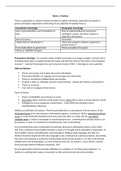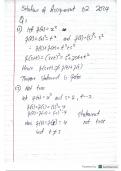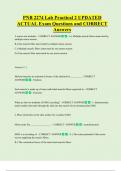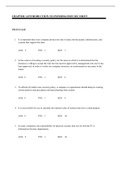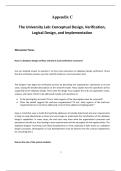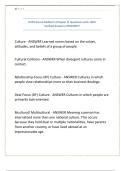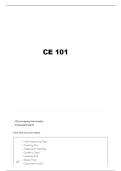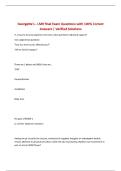Theory: supposition or system of ideas intended to explain something, especially one based on
general principles independent of the thing to be explained. (Evolution theory)
Nomothetic knowledge Ideographic knowledge
Aims at generalizations and formulations of Aims at understanding the meaning of
laws contingent, unique, and often cultural or
subjective phenomena
Natural Sciences Humanities
“Water boils at 100 degrees C” “How were property relations organized in
Ancient Greece?”
Form observations to general law Theory as toolbox (Foucault)
Theory as falsifiable (Popper)
Postmodern Nostalgia: “in a world in which stylistic innovation is no longer possible, all that is left is
to imitate dead styles, to speak through the masks and with the voices of the styles in the imaginary
museum” - Jameson Postmodernism and Consumer Society (1983) → Nostalgia as mere pastiche.
Mills and Barlow:
Theory encourages and inspires discussion and debate
Theoretical debates are ongoing, and encourage more theorizing
Theory is (sometimes) deliberatively provocative
Purpose is often to challenge common-sense thinking: “making the ordinary extraordinary”
Theory is a process
Your role is to engage in that process
Types of theory:
Theory as falsifiable versus theory as a tool
Descriptive (this is how the world works) versus critical (this is what is wrong with the world)
Endogenous versus exogenous media theory – from within the discipline versus
interdisciplinary influences.
Williams on definition of medium: There has probably been a convergence of three senses: (i) the
old general sense of an intervening or intermediate agency or substance; (ii) the conscious technical
sense, as in the distinction between print and sound and vision as media; (iii) the specialized
capitalist sense, in which a newspaper or broadcasting service - something that already exists or can
be planned - is seen as a medium for something else, such as advertising.
It is interesting that sense (i) depended on particular physical or philosophical ideas, where there
had to be a substance intermediate between a sense or a thought and its operation or expression. In
most modern science and philosophy, and especially in thinking about language, this idea of a
medium has been dispensed with; thus language is not a medium but a primary practice, and writing
(for print) and speaking or acting (for broadcasting) would also be practices. It is then controversial
whether print and broadcasting, as in the technical sense (ii), are media or, more strictly, material
forms and sign systems (Williams, Keywords, 204)
Several approaches retain the broader definition of a medium as “an intervening substance”. A
medium is anything that makes a connection so that communication becomes possible.
,“The content of any medium is always another medium” (McLuhan)
The Toronto School of Communication Theory:
Key argument: communications systems and technologies structure our individual
psychology and our culture/society
Emphasis on the form and function of media communication, rather than the content.
(Trans)historical research: comparing different eras/periods and formulate general principles
(nomothetic)
Conclusion: communication technologies are the engine of socio-historical change
Our inventions reinvent us
Innis’ bias of communication: Every medium is biased with respect to time and space: “The concepts
of time and space reflect the significance of media to civilization. Media that emphasize time are
those durable in character, such a parchment, clay and stone. The heavy materials are suited to the
development of architecture and sculpture. Media that emphasize space are apt to be less durable
and light in character such as papyrus and paper. The latter are suited to wide areas in
administration and trade. The conquest of Egypt by Rome gave access to supplies of papyrus, which
became the basis of a large administrative empire” (Empire and Communications)
McLuhan “The Medium is The Message”: We should always attend to the changes brought about by
the particular form and features of media technologies. “Societies have always been shaped more by
the nature of the media by which humans communicate than by the content of the communication”.
“The ‘message’ of any medium or technology is the change of scale or pace or pattern that it
introduces into human affairs”
Each medium has its own specific effects on our behaviour, thinking, and sense perception - these
are extended.
“Any understanding of social and cultural change is impossible without a knowledge of the way
media work as environments”
Mechanical technologies:
Extend our bodies in space
Explosion
3000 previous years
Fragmentary/taking place in time and space
, Action & reaction separated
Detachment
Examples? Literacy Electric technology
Extends our senses/consciousness
Implosion
Last 100 years
Global / instantaneous
We live integrally (“mythically”)
Involvement
Examples? Electric media
Authors:
Marshall McLuhan, 1911-1980, Canada
Global village: prediction of internet in 1962
"The Medium is the Message": Media determinism as a form of technological determinism
(Technologies alter our experience with the world), ideas formed together with Harold Innis.
They saw media as the essence of civilization. He proposed that our use of particular media
may have subtle influences on us, but more importantly, it is the social context of use that is
crucial.
University of Toronto
“Understanding Media”
Self-amputation: every invention of technology is an extension of our physical bodies, when
this is removed, we are amputated.
By continuously embracing technologies, we relate ourselves to them as servomechanisms.
The driver is a servomechanism to a car.
Implosion versus explosion: mechanic technology extends our body (into space), with
broadcasting technology, we bring the world to us (it implodes on us). Explosion takes some
time while implosion happens instantly.
Roadmap:
Metaphysics: nature of reality.
Ontology: Nature of that what exists. studies existence, being, becoming, and reality. Includes
questions about how entities are categorized. E.G. what is a human soul? What is a robot?
Neo-realism: true soul of realism, real cities with real people.
Axiology: philosophy of value, categorised in aesthetics (beauty) and ethics (behaviour).
Epistemology: the nature of knowing. How do we know? What is knowledge? What is my essence of
being? How do I know myself/others? investigation of construction of knowledge in images.

